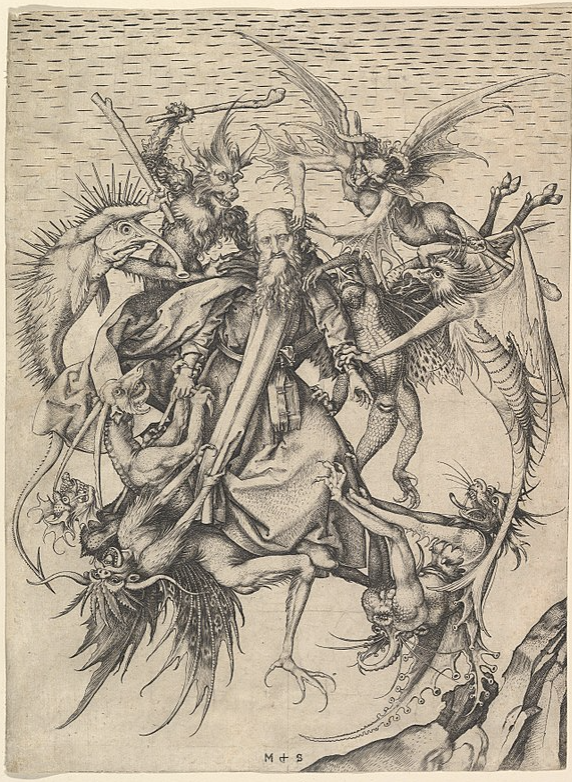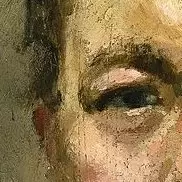Believed to be Michelangelo’s first easel painting, completed when he was 12 or 13. Based largely on an engraving by Martin Schongauer, down to the demon’s whiskered asshole:

Michelangelo’s Temptation is a mishmash of styles, particularly High Renaissance and Late Middle Ages. The foreground, ie St. Anthony being attacked by demons, is indicative of Late Middle Age art, whereas the intricate background is more on par with the Renaissance, which sought to improve on the classical art style (Ancient Greek and Roman) via realism. (https://en.wikipedia.org/wiki/High_Renaissance, https://en.wikipedia.org/wiki/Late_Middle_Ages)
From wikipedia:
The Torment of Saint Anthony (or The Temptation of Saint Anthony is attributed to Michelangelo, who painted a close copy of the famous engraving by Martin Schongauer when he was only 12 or 13 years old. Whether the painting is actually by Michelangelo is disputed. This painting is now in the Kimbell Art Museum in Fort Worth, Texas. It shows the common medieval subject, included in the Golden Legend (a big book of saints from mediaeval times) and other sources, of Saint Anthony (AD 251 – 356) being assailed in the desert by demons, whose temptations he resisted; the Temptation of St Anthony (or “Trial”) is the more common name of the subject. But this composition apparently shows a later episode where St Anthony, normally flown about the desert supported by angels, was ambushed in mid-air by devils.
From the Kimbell:
The cleaning of Michelangelo’s Torment of Saint Anthony at the Metropolitan Museum of Art, New York, in 2009, revealed the quality of the small panel. Michael Gallagher, conservator in charge of paintings conservation, removed the layers of yellowed varnish and clumsy, discolored overpaint that obscured the artist’s distinctive palette and compromised the illusion of depth and sculptural form. The technical study accompanying the cleaning provided evidence of pentimenti, or artist’s changes, signifying that the painting is an original work of art and not a copy after another painting.
Comparison of Michelangelo’s work with Schongauer’s print reveals the many ways the novice artist distilled, edited, and expanded his northern source. Most obviously, unlike Schongauer, Michelangelo set the figures against a landscape, one that resembles the familiar Arno River Valley around Florence. In addition, following a trip to the fish market, Michelangelo heightened the naturalism of Schongauer’s demons by painting silvery scales onto the spiny, fishlike monster in the upper left. In translating Schongauer’s black-and-white print into color, Michelangelo also made the creatures more lifelike. (Keith Christiansen has noted that Michelangelo’s idiosyncratic use of shades of lavender, green, and orange invites comparison to his palette in the ceiling frescoes of the Sistine Chapel.)
The young artist introduced the element of fire, which does not appear in Schongauer’s print. A small fire appears in the crevice of the rocky outcrop, flames shoot from the mouth of the demon with squid-like wings at the lower right, and a wooden club wielded by the spiny, fishlike creature has been transformed into a firebrand.
Michelangelo increased the scale of the figures and made thoughtful, calibrated shifts in their placement and the ways they interconnect, which resulted in a complete rethinking of the negative spaces between them. He straightened the tilt of Saint Anthony’s head, altered his expression, added a halo, and simplified the saint’s drapery folds. The artist reframed the heads of the demons by refining the space around them, emphasizing their fantastic, bizarre features. He also intensified the drama by moving the horns of the long-necked demon in the lower left so that the demon below could bite one of them. Overall, these changes produce a more compelling and direct figural group.
While many of Michelangelo’s changes to Schongauer’s composition are obvious to the eye alone, technical analysis carried out during cleaning—which included X-radiography, pigment analysis, infrared reflectography, and close examination under the microscope—has shed light on many other aspects of the artist’s early working methods. Adopting the egg tempera technique still practiced in Ghirlandaio’s studio, Michelangelo covered the background with continuous, parallel, horizontal brushstrokes. He modeled the saint’s face with delicate hatched brushwork over a green underpaint. X-radiography confirmed that Michelangelo executed the painting on a poplar panel and that, in the process of laying in the background, he saved space for the figure of Saint Anthony and two of the demons. The work has survived in excellent condition with only minor flake losses and some wormholes.
The infrared reflectogram mosaic captured by Charlotte Hale at the Metropolitan Museum of Art reveals the character and extent of Michelangelo’s preparatory underdrawing. The artist used two types of underdrawing in The Torment of Saint Anthony: simple, broad, black-brush outlining for the figures and drapery and much finer, more detailed underdrawing in the landscape, perhaps in silverpoint. Since the artist invented the scenery, it likely required greater preparation than the figures, which were modeled after Schongauer. With its fine, curved, parallel hatching, Michelangelo’s underdrawing in the rocky outcrop of The Torment of Saint Anthony resembles the style of his early drawing after Giotto’s fresco The Ascension of Saint John, a copy he made as part of his artistic training.
The infrared reflectogram mosaic also recorded two areas of pentimenti where Michelangelo deviated from his initial underdrawing, confirming that he continued to make critical changes at the moment of painting. He shifted the wooden club held by the spiny, fishlike monster from the angle seen in Schongauer to a more vertical position and pulled in the arc of his long tail to encircle the head of the biting monster.
Examination of the paint surface of The Torment of Saint Anthony under the microscope shows an extraordinary assurance of execution and variety of paint application as well as the effort made by the young Michelangelo to perfect his composition. The heavy layering of paint in some of the demons suggests that the artist’s choice of color evolved as he transformed the black-and-white figures into colored beasts. Michelangelo applied pigment with brushes but then frequently attacked the surface with a sculptor’s tool. He scraped away paint along the back of the spiny, fishlike monster, exposing the underlying gesso and enhancing the sculptural form of the thick scales, which are painted in relief. The artist also sharpened the outlines of the demon with incisions. In a final stage of painting, Michelangelo made numerous adjustments to edges throughout the composition using the light background color. The exacting nature of these corrections suggests his obsession with the refinement of these contours.
The combined techniques of painting in relief, scraping, and incising have been previously noted in The Manchester Madonna and The Entombment, two unfinished works by the artist in the National Gallery, London. When considered together with the documentary evidence of Condivi and Vasari’s biographies as well as stylistic analysis, the technical examination of The Torment of Saint Anthony adds powerful evidence that the Kimbell panel is Michelangelo’s first easel painting.
https://kimbellart.org/content/michelangelo-torment-saint-anthony


Tag yourself, I’m the spiny fish demon in the top left
Seriously though, this is pretty cool. I love the variety of demons, so much weirdness like the guy with a face-butt on the bottom right
deleted by creator